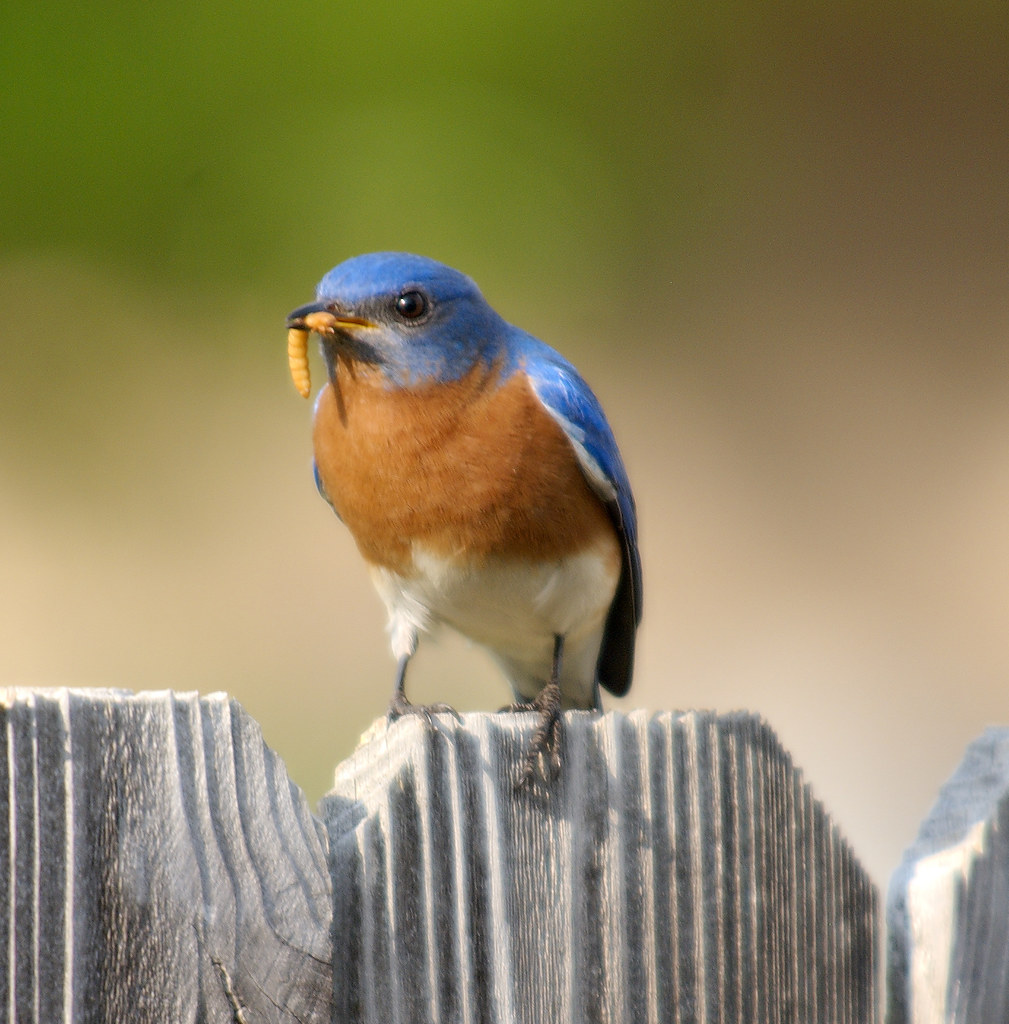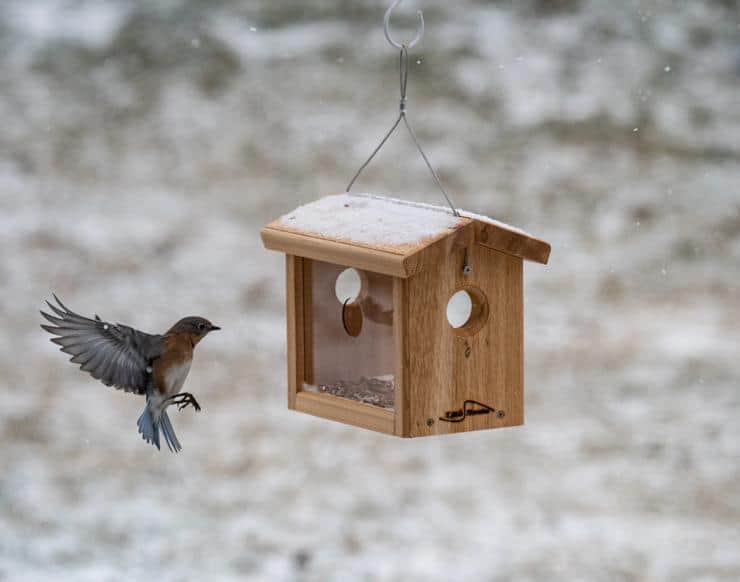
As a avid bluebird enthusiast of sixteen years, I have learned a lot about what bluebirds eat at different times of the year. During the summer I constantly see bluebirds gobbling up caterpillars, crickets, and other bugs. They gracefully swoop to the ground to catch them. But, as it turns out, even though they prefer insects in the summer, bluebirds actually eat a lot of different foods in the winter (and they’re picky too). So, since bluebirds have such a unique diet, if you’re trying to attract them to your backyard feeder, you’ll need to know a few things about what to feed bluebirds in the winter.
The best foods to feed bluebirds in the winter are fruit, mealworms, hulled sunflower seeds, peanut butter, and suet. Bluebirds will readily accept these five foods in the winter when insects are harder to find. The high calorie density of these foods will also help bluebirds survive during harsh winter conditions.
The above photo by scrapkat1 is licensed under CC BY-ND 2.0
Best Nest Box: My all-time favorite nest box for bluebirds is the Nature’s Way model CWH4. It has so many features that I love. Get one of these bird houses on Amazon here.
Let’s look at each of these foods one-by-one and consider the best ways to offer each type of food at a feeder in order to attract bluebirds.
1. Fruit: Bluebirds’ Favorite Winter Food

Photo by holdit, license: CC BY-NC-ND 2.0
Why Bluebirds Love Fruit:
Bluebirds eat A LOT of fruit in the winter. As the ground freezes and insects become harder to find, bluebirds naturally switch from an insect-centered diet to a fruit-centered diet. They go from catching caterpillars, spiders, and crickets in June to munching on mistletoe, sumac, and wild holly in December. It’s safe to say that fruit is a bluebird’s favorite winter food.
How To Offer Fruit at a Feeder:
Since bluebirds naturally eat so much fruit in the winter, they will gladly accept fruit at your feeder too, if you offer it. You can easily serve your fruit on a platform feeder or in a hanging bluebird feeder. (See my recommended feeders on my tools page.)
For fresh fruit, try offering sections of apples or pears that have been finely diced, or whole berries, like blueberries, blackberries or raspberries.
If you want to offer bluebirds dried fruit, raisins and dried currants are both great options. Chop them up and soak them in hot water for at least a half hour before serving. The soaking process will soften the dried fruit so that it is more easily digestible for bluebirds.
If you want to attract bluebirds to your yard THIS YEAR, the best place to start is the Bluebird Landlord Audio Guide. In this audio guide, I’ll tell you everything you need to know about attracting bluebirds in just 59 minutes and 38 seconds.
Check out the Bluebird Landlord Audio Guide here.
2. Mealworms: A Great Year-Round Food for Bluebirds

Photo by dbarronoss, license: CC BY-NC-ND 2.0
Why Bluebirds Love Mealworms:
Offering mealworms is one of the best ways to attract bluebirds to your yard, in all seasons, even during the winter. Mealworms are a great choice because they are fairly easy to find, both online and at bait shops, and bluebirds really go crazy for them. The great thing is, they’re also a healthy choice for bluebirds.
Bluebirds’ main diet consists of invertebrates, like spiders, caterpillars, and other insects – and mealworms fit right into that same category. They’re an insect (technically the larva of the mealworm beetle). And they have a body type, protein content, and nutritional profile that matches other bugs that bluebirds regularly consume.
So, if you are trying to keep bluebirds happy during the winter months, consider feeding them a food they can’t resist – mealworms. While bluebirds prefer live mealworms, if you’re not interested in the maintenance that comes with storing live insects at home, bluebirds will gladly eat dried mealworms too.
How To Feed Bluebirds Mealworms In The Winter:
Try offering a handful of live mealworms in a platform feeder, or better yet, in a hanging bluebird feeder that is placed relatively close to a bluebird nest box. Be patient and allow your bluebirds time to discover the feeder. Once your bluebirds know where the feeder is, the wiggling of the mealworms will attract them like a magnet!

You can also offer handfuls of dried mealworms at the same types of feeders, preferably mixed in with dried fruit and other things that bluebirds like to eat in the winter.
On my Recommended Tools page I recommend my favorite bluebird feeders and give a few sources for where you can buy live and dried mealworms. Check out that page here.
3. Hulled Sunflower Seeds

Photo by Vicki’s Nature, license: CC BY-NC-ND 2.0
Why Sunflower Seeds Work For Bluebirds:
While they are not stereotypical seed-eaters, bluebirds will eat hulled sunflower seeds if you offer them at a feeder. Hulled sunflower seeds, which lack the hard exterior shell, are chosen often by bluebirds, are safe for them to digest, and they are a relatively cheap feeder option.
How To Offer This Food at a Feeder:
The best way to serve hulled sunflower seeds is on a platform feeder or in a hanging bluebird feeder. Click here to see my favorite platform feeder on Amazon.
If your bluebirds are already eating fruit or mealworms at a feeder, just offer some sunflower seeds along with them. The birds will likely appreciate the variety, and they’ll be more trusting of the new food if you feed it to them in a familiar spot.
4. Peanut Butter: A High-Calorie Feast That Bluebirds Love in the Winter

Why Bluebirds Love Peanut Butter:
My favorite food to feed bluebirds in the winter is peanut butter. Bluebirds happily gobble up peanut butter in the winter, likely because the high calorie content will help them survive the cold weather if other food sources are scarce. This, added to the fact that peanut butter binds well with other foods, makes this a winter staple at my bluebird feeders.
How To Offer This Food at a Feeder:
When choosing a type of peanut butter to offer at your feeder, one that is labeled as “natural” is usually the best choice. Natural peanut butter usually doesn’t contain hydrogenated oils (but check the ingredients list to be sure). My choice is Smucker’s Natural Peanut Butter, which only contains two ingredients: peanuts and salt.
And if you’re wondering, chunky peanut butter is better than creamy, because bluebirds seem to like picking out the peanut pieces, although this is probably just a minor preference.
You can feed bluebirds peanut butter by putting it directly on a platform feeder, but for a less messy option I recommend mixing the peanut butter with some other ingredients to make a denser and more solid mix.
Here’s a peanut butter-based recipe that I love to offer bluebirds in the winter:
Winter Bluebird Recipe: Peanut Butter Muffins
Ingredients
- Chunky Natural Peanut Butter – 16 oz.
- Lard or Shortening- 16 oz.
- Cornmeal – 1 1/2 lb. bag
Directions
- Heat the peanut butter jar in the microwave for 30 seconds so it will release easily from the jar.
- Heat the lard in the microwave for 30 seconds so if will loosen slightly too.
- Mix the entire jar of peanut butter and container or lard in a large mixing bowl.
- Stir to completely combine.
- Add half of the bag of cornmeal and fold it into the peanut butter mixture.
- Add the rest of the cornmeal and fold it into the peanut butter mixture.
- Mix everything together completely. It should be between a batter and a paste in consistency.
- Use an ice cream scoop to divide the batter into 12-16 muffin cups. Use a silicone muffin tin or muffin tin liners.
- Place the muffin tins into the freezer until the peanut butter muffins are frozen solid.
- Now you can unwrap a few muffins and place them on your bluebird feeder and move the rest to a plastic bag and store them in the freezer.
- These should last in the freezer for a month or two.
Watch the video of me making this recipe below.
And finally, let’s look at the last food on the list: suet.
5. Suet

Photo by NCReedplayer, license: CC BY-NC-SA 2.0
Why Bluebirds Love Suet:
Suet, a hard fat product usually harvested from beef, is loaded with calories that help sustain a lot of birds throughout the winter. Suet is usually sold in blocks mixed with a variety of seeds. While bluebirds won’t be attracted to every type of suet you can find hardware store, they do eat suet when it is mixed with other bluebird-friendly foods, like hulled sunflower seeds or dried mealworms.
How To Offer Suet at a Feeder:
I prefer not to make my own suet mixes, since I can usually find some good suet options at hardware stores and online. One suet blend that I love is called “Bluebird Nuggets,” which is a suet and peanut butter blend. You can get bags of it on online at a pretty good price. Check the current price on Amazon here.
To offer these, place a few handfuls of nuggets on a platform feeder or in a hanging bluebird feeder at a time when you usually see bluebirds flying around.
I also like the full suet blocks called “Mealworm Delight” made by C&S Products. These are a mix of suet, peanut butter, and mealworms. You can get a pack of four Mealworm Delight suet blocks on Amazon here.
It’s best to offer these inside of a cage-style suet feeder like this one from Amazon. But you can also put a block of suet on a platform feeder or inside a hanging bluebird feeder just fine. When they’re hungry during a cold winter, as long as you offer the food in a thoughtful place, bluebirds will find it!
I hope this article helps you attract bluebirds to your yard and know what to feed them in the winter! To learn more about where to get the best feeders, food, and nest boxes for bluebirds, check our my Recommended Tools page here.

